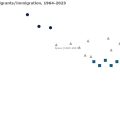In 1995, while Elon Musk was kicking off his first venture in Silicon Valley, another entrepreneur, Wang Chuanfu, was starting his own journey in Shenzhen with BYD, making batteries for Motorola. It’s wild to think that nearly three decades later, Musk and Wang would be leading two of the biggest names in electric vehicles, caught in a geopolitical tug-of-war that’s all about manufacturing, energy, tech, and tariffs.
The rivalry between Tesla, Inc. (TSLA) and BYD Company Limited (BYDDY) isn’t as clear-cut as it seems. Despite being on opposite sides of a geopolitical divide, their businesses are deeply intertwined. Tesla’s second-largest market and biggest factory are in China, with significant investment from billionaires like He Xiaopeng. On the flip side, BYD’s largest external shareholders are American giants like Berkshire Hathaway and Blackrock, and it even supplied the largest-ever order for electric buses in the U.S. Plus, BYD sells batteries to Tesla.
These examples illustrate the difficulty of ‘de-risking’ between two deeply intertwined economies and determining who is ‘winning’ at any given moment. One thing’s for sure, though: both Wang and Musk remain optimistic about the future.
Tesla vs. BYD: The Competition Is Hot on Its Heels
While TSLA enjoys a near-mythical status among EV enthusiasts, BYD is rapidly closing the gap. In the last quarter, Tesla delivered 443,956 all-electric cars, 5% less than a year ago but 14.8% more than the previous quarter. Meanwhile, BYD’s sales volume surged 28.8% in July compared to the previous year, reaching 342,383 vehicles. In the first quarter, BYD was only 18,000 cars short of Tesla’s deliveries from April to June 2024, indicating how close this race is getting.
TSLA’s total revenues for the second quarter ended June 30, 2024, increased 2.2% from the previous year to $25.50 billion, showcasing its continued growth and success. However, BYD’s strong performance, with a 4% year-over-year increase in operating revenue, indicates a shifting landscape in the EV market, with BYD poised to challenge Tesla’s long-standing dominance.
On the bottom line, TSLA’s non-GAAP net income and EPS for the second quarter declined by 45% and 43% year-over-year to $1.81 billion and $0.52, respectively. In contrast, BYDDY’s attributable net profit for the March quarter grew 10.6% from the prior year to RMB4.57 billion ($640.82 million). Moreover, its EPS stood at RMB1.57, up 10.5% year-over-year.
Despite Tesla’s recent decline in profits, it has maintained its leadership position in EV deliveries, thanks to its significant advantage over other manufacturers in previous years. But with BYD closing in, the competition in the EV market is only getting hotter.
Tesla Has a Massive Leg Up on Its Competitors
Tesla is building EVs cheaper than anyone else, and it’s giving Elon Musk’s company an edge even with increasing competition. According to Bank of America, Tesla spends less than $30,000 on components per vehicle. This is $17,000 cheaper than other EV makers and about $10,000 below the industry average. Despite shrinking margins and slowing sales, these lower costs keep Tesla ahead of traditional automakers like Ford Motor Company (F) and General Motors Company (GM), who still rely on profits from gas-powered cars and haven’t yet made a profit on their EVs.
High input costs lead to higher consumer prices, making it challenging for TSLA’s competitors to compete in a price-sensitive market. To make its cars even more affordable, the company offered attractive financing options in Q2, helping to offset high interest rates.
Elon Musk has big plans to compete with Uber Technologies, Inc. (UBER) through Tesla’s autonomous (self-driving) robotaxis dubbed ‘Cybercab’. Musk is heavily investing in this technology and aims to release a more advanced, steering-wheel-free model possibly this fall. He envisions Tesla owners renting out their cars as self-driving taxis, similar to Airbnb, Inc. (ABNB), which could pose a severe challenge to ride-sharing giants like Uber and Lyft.
The idea is that Tesla owners can earn extra income by letting their cars operate as robotaxis during their off hours, with Tesla taking a cut of the profits. Musk even predicts that each participating Tesla could generate around $30,000 in gross earnings annually for its owner.
In a recent earnings call, Musk mentioned significant progress in full self-driving technology, with version 12.5 showing notable improvements. He also announced a slight delay in the Robotaxi product reveal, now scheduled for October 10th, to allow for essential updates and enhancements. Additionally, Tesla is ramping up production in its U.S. factory and building a new Megapack factory in China, potentially tripling its output.
BYD Joins Forces With Uber to Close the Gap With Tesla
BYD, Tesla’s biggest competitor, has just struck a major deal with UBER. The deal aims to bring 100,000 BYD electric vehicles (EVs) to Uber’s global fleet, starting in Europe and Latin America before expanding to other regions. To encourage drivers to switch to EVs, both companies would offer incentives like discounts on maintenance, charging, financing, and leasing.
This move comes as global EV sales slow and Chinese automakers face higher import tariffs. The collaboration aims to lower the total cost of EV ownership for Uber drivers, boosting EV adoption on Uber’s platform and providing greener rides for millions of users.
BYD is also working on integrating its self-driving technology into Uber’s platform. With $14 billion invested in smart cars, BYD is developing a “Navigate on Autopilot” feature similar to Tesla’s “Autopilot,” which could potentially make BYD-Uber autonomous vehicles direct competitors to Tesla’s robotaxis.
BYD is expanding its production facilities outside China in response to increased tariffs on Chinese-made EVs. The company has recently secured a $1 billion deal to build a new manufacturing plant in Turkey, which will produce up to 150,000 vehicles annually and create around 5,000 jobs by 2026. They’ve also opened an EV plant in Thailand, with similar production capacity and expected to generate 10,000 jobs. Additionally, BYD plans to establish a passenger car factory in Hungary and another in Mexico.
Given these strategic diversifications and a focus on innovation, BYD has transformed into a global EV powerhouse. The company’s hefty investments in expanding its production capacity and approach to vertical integration have further solidified its competitive edge in the EV market??.
Bottom Line
BYD’s strategic focus on electric and hybrid vehicles, along with its tech innovations and global expansion, makes it a serious contender against Tesla. As the EV market evolves, the competition between BYDDY and TSLA is expected to intensify, with both companies pushing hard to lead the charge and grab a bigger slice of the global market. The battle for EV dominance is far from over, and it would be interesting to see how these two giants move forward will shape the future of electric mobility.




